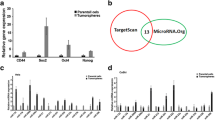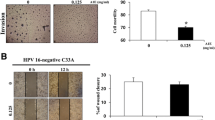Abstract
Objective
To explore whether casticin (CAS) suppresses stemness in cancer stem-like cells (CSLCs) obtained from human cervical cancer (CCSLCs) and the underlying mechanism.
Methods
Spheres from HeLa and CaSki cells were used as CCSLCs. DNA methyltransferase 1 (DNMT1) activity and mRNA levels, self-renewal capability (Nanog and Sox2), and cancer stem cell markers (CD133 and CD44), were detected by a colorimetric DNMT activity/inhibition assay kit, quantitative real-time reverse transcription-polymerase chain reaction, sphere and colony formation assays, and immunoblot, respectively. Knockdown and overexpression of DNMT1 by transfection with shRNA and cDNA, respectively, were performed to explore the mechanism for action of CAS (0, 10, 30, and 100 nmol/L).
Results
DNMT1 activity was increased in CCSLCs compared with HeLa and CaSki cells (P<0.05). In addition, HeLa-derived CCSLCs transfected with DNMT1 shRNA showed reduced sphere and colony formation abilities, and lower CD133, CD44, Nanog and Sox2 protein expressions (P<0.05). Conversely, overexpression of DNMT1 in HeLa cells exhibited the oppositive effects. Furthermore, CAS significantly reduced DNMT1 activity and transcription levels as well as stemness in HeLa-derived CCSLCs (P<0.05). Interestingly, DNMT1 knockdown enhanced the inhibitory effect of CAS on stemness. As expected, DNMT1 overexpression reversed the inhibitory effect of CAS on stemness in HeLa cells.
Conclusion
CAS effectively inhibits stemness in CCSLCs through suppression of DNMT1 activation, suggesting that CAS acts as a promising preventive and therapeutic candidate in cervical cancer.
Similar content being viewed by others
Data Availability Statement
The data used to support the findings of this study are available from the corresponding author upon request.
References
Knaul FM, Rodriguez NM, Arreola-Ornelas H, Olson JR. Cervical cancer: lessons learned from neglected tropical diseases. Lancet Glob Health 2019;7:e299–e300.
Siegel RL, Miller KD, Jemal A. Cancer statistics, 2020. CA Cancer J Clin 2020;70:7–30.
Arbyn M, Weiderpass E, Bruni L, de Sanjosé S, Saraiya M, Ferlay J, et al. Estimates of incidence and mortality of cervical cancer in 2018: a worldwide analysis. Lancet Glob Health 2020;8:e191–e203.
Beck B, Blanpain C. Unravelling cancer stem cell potential. Nat Rev Cancer 2013;13:727–738.
Organista-Nava J, Gómez-Gómez Y, Garibay-Cerdenares OL, Leyva-Vázquez MA, Illades-Aguiar B. Cervical cancer stem cell-associated genes: prognostic implications in cervical cancer. Oncol Lett 2019;18:7–14.
Strauss J, Figg WD. Epigenetic approaches to overcoming chemotherapy resistance. Lancet Oncol 2015;16:1013–1015.
Pathania R, Ramachandran S, Elangovan S, Padia R, Yang P, Cinghu S, et al. DNMT1 is essential for mammary and cancer stem cell maintenance and tumorigenesis. Nat Commun 2015;6:6910.
Trowbridge JJ, Sinha AU, Zhu N, Li M, Armstrong SA, Orkin SH. Haploinsufficiency of DNMT1 impairs leukemia stem cell function through derepression of bivalent chromatin domains. Genes Dev 2012;26:344–349.
Shafabakhsh R, Asemi Z. Quercetin: a natural compound for ovarian cancer treatment. J Ovarian Res 2019;12:55.
Maiuthed A, Chantarawong W, Chanvorachote P. Lung cancer stem cells and cancer stem cell-targeting natural compounds. Anticancer Res 2018;38:3797–3809.
Kim C, Kim B. Anti-cancer natural products and their bioactive compounds inducing ER stress-mediated apoptosis: a review. Nutrients 2018;10:1021.
Cheng ZY, Hsiao YT, Huang YP, Peng SF, Huang WW, Liu KC, et al. Casticin induces DNA damage and affects DNA repair associated protein expression in human lung cancer A549 cells. Molecules 2020;25:341.
He G, Cao X, He M, Sheng X, Wu Y, Ai X. Casticin inhibits self-renewal of liver cancer stem cells from the MHCC97 cell line. Oncol Lett 2014;7:2023–2028.
Liu F, Cao X, Liu Z, Guo H, Ren K, Quan M, et al. Casticin suppresses self-renewal and invasion of lung cancer stemlike cells from A549 cells through down-regulation of pAkt. Acta Biochim Biophys Sin 2014;46:15–21.
He M, Cao XC, He GC, Sheng XF, Ai XH, Wu YH. Casticin inhibits epithelial-mesenchymal transition of liver cancer stem cells of the SMMC-7721 cell line through downregulating Twist. Oncol Lett 2014;7:1625–1631.
Cao X, Zou H, Cao J, Cui Y, Sun S, Ren K, et al. A candidate Chinese medicine preparation-Fructus Viticis total flavonoids inhibits stem-like characteristics of lung cancer stem-like cells. BMC Complement Altern Med 2016;16:364.
Yang F, He K, Huang L, Zhang L, Liu A, Zhang J. Casticin inhibits the activity of transcription factor Sp1 and the methylation of RECK in MGC803 gastric cancer cells. Exp Ther Med 2017;13:745–750.
Li X, Wang L, Cao X, Zhou L, Xu C, Cui Y, et al. Casticin inhibits stemness of hepatocellular carcinoma cells via disrupting the reciprocal negative regulation between DNMT1 and miR-148a-3p. Toxicol Appl Pharmacol 2020;396:114998.
Liu J, Cao XC, Xiao Q, Quan MF. Apigenin inhibits HeLa sphere-forming cells through inactivation of casein kinase 2α. Mol Med Rep 2015;11:665–669.
Wang L, Liu Y, Zhou Y, Wang J, Tu L, Sun Z, et al. Zoledronic acid inhibits the growth of cancer stem cell derived from cervical cancer cell by attenuating their stemness phenotype and inducing apoptosis and cell cycle arrest through the Erk1/2 and Akt pathways. J Exp Clin Cancer Res 2019;38:93.
Cao X, Liu L, Cao X, Cui Y, Zou C, Chen A, et al. The DNMT1/miR-34a/FOXM1 axis contributes to stemness of liver cancer cells. J Oncol 2020;2020:8978930.
She S, Zhao Y, Kang B, Chen C, Chen X, Zhang X, et al. Combined inhibition of JAK1/2 and DNMT1 by newly identified small-molecule compounds synergistically suppresses the survival and proliferation of cervical cancer cells. Cell Death Dis 2020;11:724.
Piyathilake CJ, Badiga S, Borak SG, Weragoda J, Bae S, Matthews R, et al. A higher degree of expression of DNA methyl transferase 1 in cervical cancer is associated with poor survival outcome. Int J Womens Health 2017;9:413–420.
Jiang H, Cao HJ, Ma N, Bao WD, Wang JJ, Chen TW, et al. Chromatin remodeling factor ARID2 suppresses hepatocellular carcinoma metastasis via DNMT1-Snail axis. Proc Natl Acad Sci U S A 2020;117:4770–4780.
Arbyn M, Weiderpass E, Bruni L, de Sanjosé S, Saraiya M, Ferlay J, Bray F. Estima tes of incidence and mortality of cervical cancer in 2018: a worldwide analysis. Lancet Glob Health 2020;8:e191–e203.
Mancarella D, Plass C. Epigenetic signatures in cancer: proper controls, current challenges and the potential for clinical translation. Genome Med 2021;13:23.
Li T, Wang L, Du Y, Xie S, Yang X, Lian F, et al. Structural and mechanistic insights into UHRF1-mediated DNMT1 activation in the maintenance DNA methylation. Nucleic Acids Res 2018;46:3218–3231.
Nishiyama A, Mulholland CB, Bultmann S, Kori S, Endo A, Saeki Y, et al. Two distinct modes of DNMT1 recruitment ensure stable maintenance DNA methylation. Nat Commun 2020;11:1222.
Chen YZ, Wang JW, Meng FC, Yang P, Zhang XG, Wu HZ. LncRNATCF7 up-regulates DNMT1 mediated by HPV-18 E6 and regulates biological behavior of cervical cancer cells by inhibiting miR-155. Eur Rev Med Pharmacol Sci 2019;23:8779–8787.
Li L, Wang S. DNA methyltransferase (DNMTs) expression in cervical cancer tissues and its relationship with HPV infection and tumor malignancy. J Hainan Med Univ (Chin) 2017;23:136–139.
Faghihloo E, sadeghiZadeh M, shahmahmoodi S, moKhTari-aZad T. Transcriptional suppression of E-cadherin by HPV-16 E6 and E7 oncogenes is independent of hypermethylation of E-cadherin promoter. Iran Red Crescent Med 2017;19:e30434.
Liu H, Song Y, Qiu H, Liu Y, Luo K, Yi Y, et al. Downregulation of FOXO3a by DNMT1 promotes breast cancer stem cell properties and tumorigenesis. Cell Death Differ 2020;27:966–983.
Zagorac S, Alcala S, Fernandez Bayon G, Bou Kheir T, Schoenhals M, González-Neira A, et al. DNMT1 inhibition reprograms pancreatic cancer stem cells via upregulation of the mir-17-92 cluster. Cancer Res 2016;76:4546–4558.
Liu CC, Lin JH, Hsu TW, Su K, Li AF, Hsu HS, et al. IL-6 enriched lung cancer stem-like cell population by inhibition of cell cycle regulators via DNMT1 upregulation. Int J Cancer 2015;136:547–559.
Rasul A, Zhao BJ, Liu J, Liu B, Sun JX, Li J, et al. Molecular mechanisms of casticin action: an update on its antitumor functions. Asian Pac J Cancer Prev 2014;15:9049–9058.
Lee JG, Yon JM, Lin C, Jung AY, Jung KY, Nam SY. Combined treatment with capsaicin and resveratrol enhances neuroprotection against glutamate-induced toxicity in mouse cerebral cortical neurons. Food Chem Toxicol 2012;50:3877–3785.
Chan EWC, Wong SK, Chan HT. Casticin from Vitex species: a short review on its anticancer and anti-inflammatory properties. J Integr Med 2018;16:147–152.
Author information
Authors and Affiliations
Contributions
Wang XL performed and analyzed the experiments, wrote the paper. Cao XZ, Wang DY, Qiu YB, Deng KY, Cao JG, Lin SQ and Xu Y carried out the data collection and data analysis. Ren KQ conceived and coordinated the study, participated in data analysis, and revised the paper. All authors contributed to data analysis, drafting or revising the article, gave final approval of the version to be submitted, and agree to be accountable for all aspects of the work.
Corresponding author
Ethics declarations
The authors declare that there is no conflict of interest.
Additional information
Supported by the National Natural Science Foundation of China (No. 82074075), Scientific Research Fund of Hunan Provincial Education Department (No. 20C1340), the Key Laboratory of Study and Discovery of Small Targeted Molecules of Hunan Province, Hunan Normal University (No. 2017TP1020), and the Huxiang High-Level Talent Innovation Team (No. 2018RS3072) 1. Medical College, Hunan University of Medicine, Huaihua, Hunan Province (418000), China; 2. Clinical Department of Guangdong Metabolic Disease Research Centre of Integrated Chinese and Western Medicine, the First Affiliated Hospital of Guangdong Pharmaceutical University, Guangzhou (510062), China; 3. Institute of Chemical Biology, Guangzhou Institutes of Biomedicine and Health, Chinese Academy of Sciences, Guangzhou (510530), China; 4. The Key Laboratory of Model Animals and Stem Cell Biology in Hunan Province, Medical College, Hunan Normal University, Changsha (410013), China; 5. The Key Laboratory of Study and Discover of Small Targeted Molecules of Hunan Province, Medical College, Hunan Normal University, Changsha (410013), China
Rights and permissions
About this article
Cite this article
Wang, Xl., Cao, Xz., Wang, Dy. et al. Casticin Attenuates Stemness in Cervical Cancer Stem-Like Cells by Regulating Activity and Expression of DNMT1. Chin. J. Integr. Med. 29, 224–232 (2023). https://doi.org/10.1007/s11655-022-3469-z
Accepted:
Published:
Issue Date:
DOI: https://doi.org/10.1007/s11655-022-3469-z




